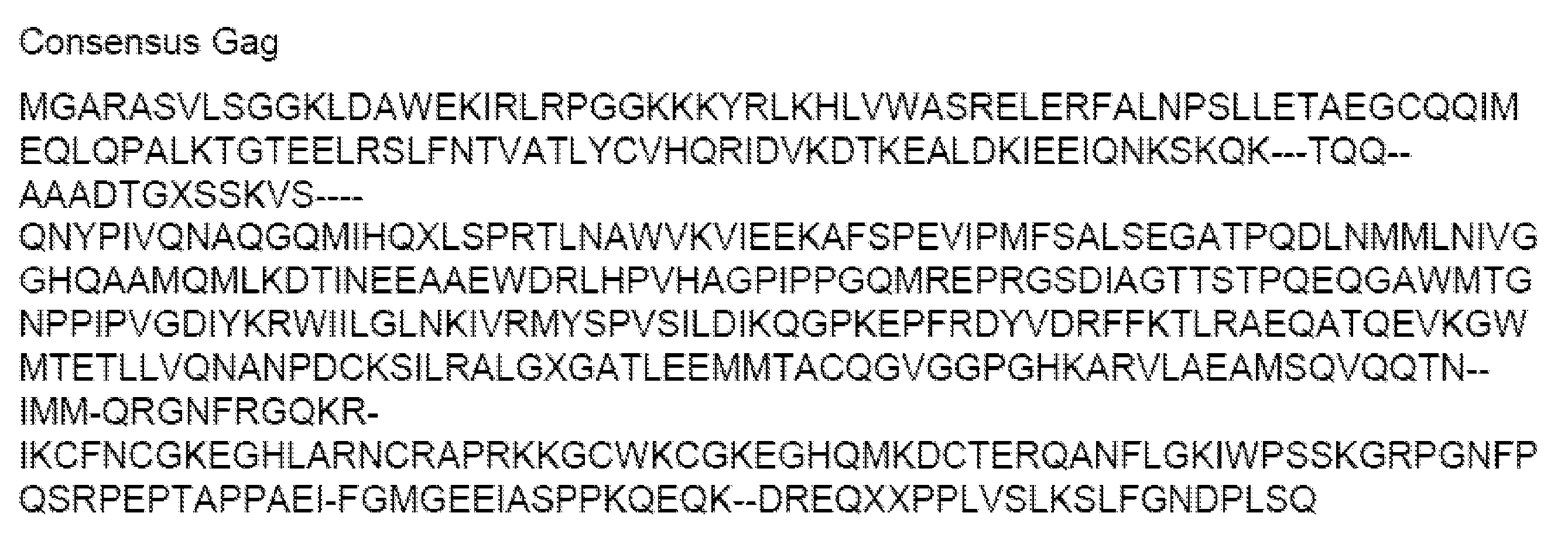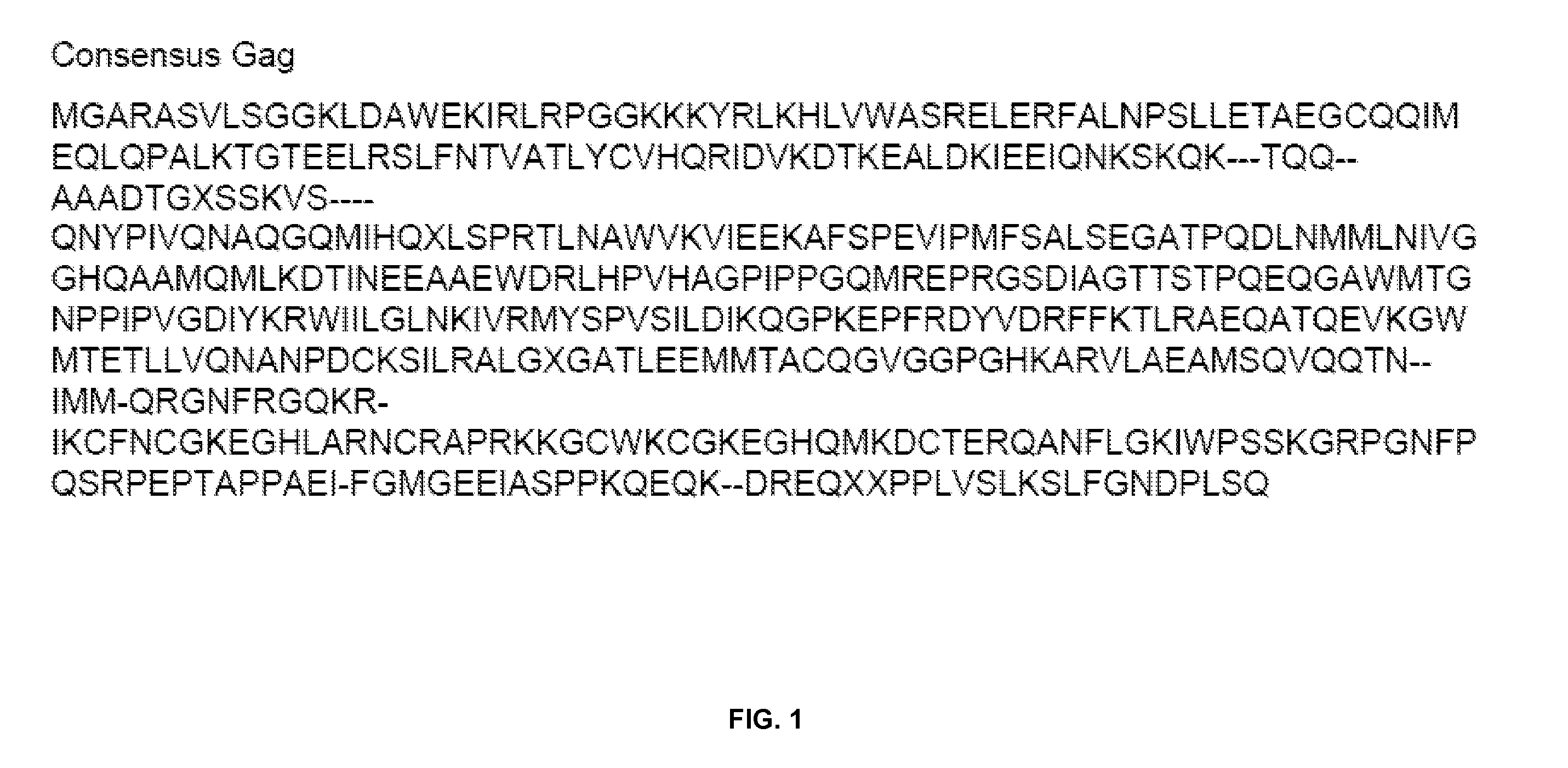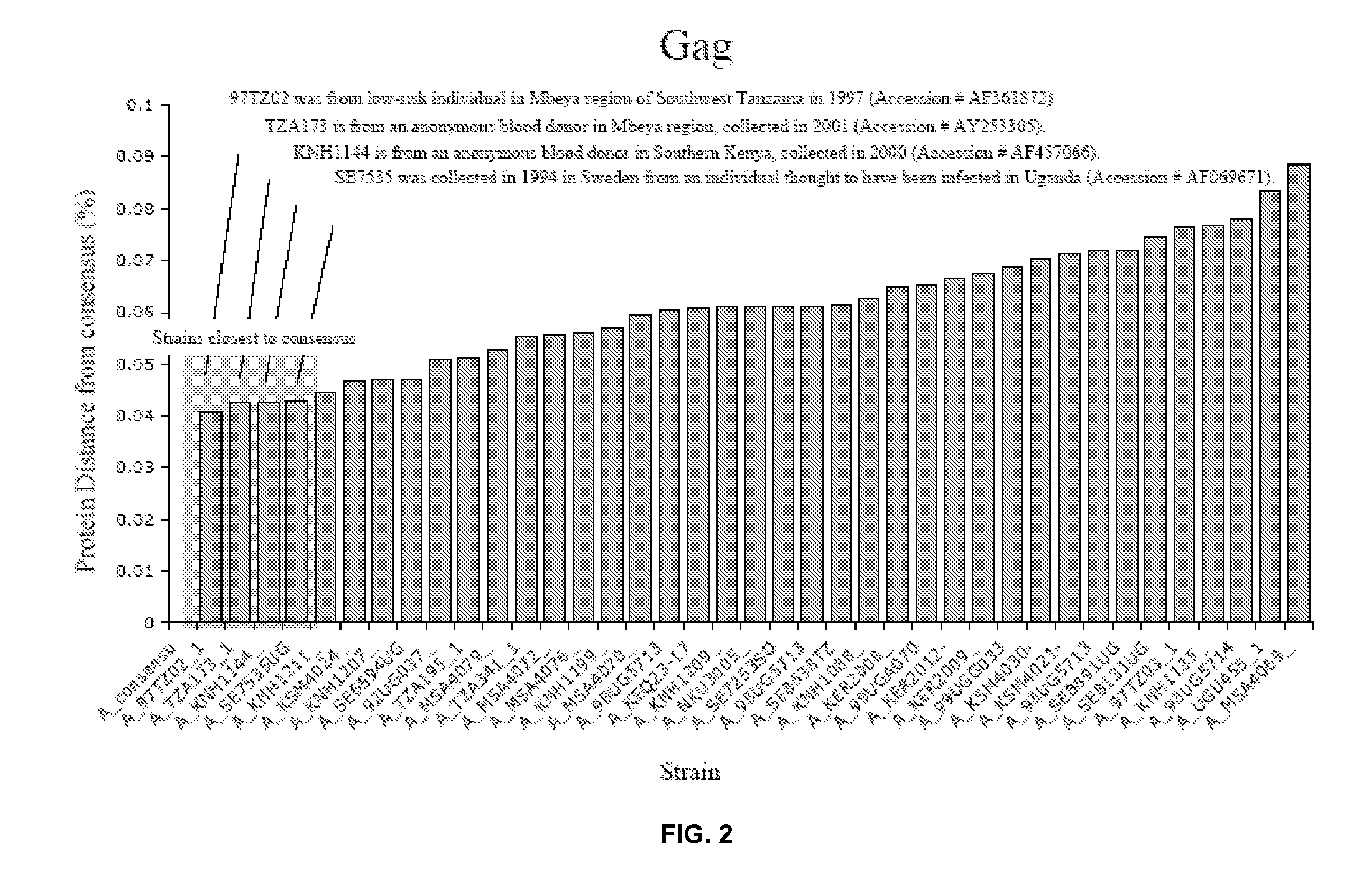HIV-1 clade a consensus sequences, antigens, and transgenes
- Summary
- Abstract
- Description
- Claims
- Application Information
AI Technical Summary
Benefits of technology
Problems solved by technology
Method used
Image
Examples
example 1
Consensus Sequence for Gag of HIV Clade A
[0107]
TABLE 1Distance fromconsensusCountryYearA_consensu0A_97TZ02_10.04081TZ1997A_TZA173_10.0425TZ2001A_KNH1144—0.04259KE2000A_SE7535UG0.04303UG1994A_KNH1211—0.04463KE2000A_KSM4024—0.04684KE2000A_KNH1207—0.04701KE2000A_SE6594UG0.04709UG1993A_92UG037—0.05079UG1992A_TZA195_10.05127TZ2001A_MSA4079—0.05279KE2000A_TZA341_10.05523TZ2001A_MSA4072—0.05583KE2000A_MSA4076—0.056KE2000A_KNH1199—0.05687KE2000A_MSA4070—0.05947KE2000A_98UG57130.06038UG1998A_KEQ23-170.06072KE1994A_KNH1209—0.06101KE2000A_NKU3005—0.06108KE2000A_SE7253SO0.06113SO1994A_98UG57130.06119UG1998A_SE8538TZ0.06137TZ1995A_KNH1088—0.06262KE1999A_KER2008—0.065KE2000A_99UGA0700.06531UG1999A_KER2012-0.06654KE2000A_KER2009—0.0674KE2000A_99UGG0330.06871UG1999A_KSM4030-0.07026KE2000A_KSM4021-0.07145KE1999A_98UG57130.07189UG1998A_SE8891UG0.07197UG1995A_SE8131UG0.07462UG1995A_97TZ03_10.07653TZ1997A_KNH1135—0.07687KE1999A_98UG57140.0781UG1998A_UGU455_10.08349UG1985A_MSA4069—0.08867KE2000
[0108] T...
example 2
Consensus Sequence for Pol of HIV Clade A
[0112] The amino acid sequences of the Pol proteins of 36 non-recombinant HIV Clade A strains were analyzed. Table 2 lists the 36 strains used, and refers to each by its Genbank accession number. Table 2 also identifies the country and year of isolation of each of these 36 strains. 20 of the strains were from Kenya, 9 from Uganda, 6 from Tanzania, and 1 from Somalia. 19 of the strains were isolated between 2000 and 2002, 10 were isolated between 1997 and 1999, 4 were isolated between 1994 and 1996 and 3 were isolated before 1993.
[0113] The Pol protein sequences were aligned. There were no insertions or deletions. A 50% consensus sequence was derived. The consensus amino acid sequence is shown FIG. 3. In FIG. 3 the positions for which a 50% consensus was not attained are represented by an “X. There were 4 such positions out of 947 amino acid residues. For each of the 36 sequences used to generate the consensus sequence, the “distance” of tha...
example 3
Consensus Sequence for Env of HIV Clade A
[0115]
TABLE 3Dist fromA.conscountryYearA.cons0A_KEQ23-170.06307KE1994A_TZA341_10.06413TZ2001A_KNH1088—0.06524KE1999A_KNH1209—0.0699KE2000A_KNH1144—0.07088KE2000A_99UGA0700.07365UG1999A_MSA4072—0.07516KE2000A_KSM4021-0.0778KE1999A_97TZ02_10.07825TZ1997A_KNH1199—0.07883KE2000A_MSA4079—0.07944KE2000A_SE7535UG0.08375UG1994A_SE8538TZ0.08432TZ1995A_98UG57130.08462UG1998A_97TZ03_10.08541TZ1997A_MSA4070—0.0874KE2000A_NKU3005—0.0884KE2000A_TZA173_10.09046TZ2001A_KNH1207—0.09106KE2000A_TZA195_10.09389TZ2001A_MSA4076—0.09517KE2000A_92UG037—0.098UG1992A_98UG57140.09816UG1998A_SE7253SO0.09886SO1994A_KER2012-0.09984KE2000A_98UG57130.10139UG1998A_SE6594UG0.10195UG1993A_SE8891UG0.10225UG1995A_UGU455_10.10314UG1985A_KER2009—0.10338KE2000A_KNH1211—0.11319KE2000A_SE8131UG0.11321UG1995A_MSA4069—0.11507KE2000A_99UGG0330.11653UG1999A_KNH1135—0.11713KE1999A_KER2008—0.12689KE2000
[0116] The amino acid sequences of the Env proteins of 36 non-recombinant HIV Clade A s...
PUM
| Property | Measurement | Unit |
|---|---|---|
| Fraction | aaaaa | aaaaa |
| Immunogenicity | aaaaa | aaaaa |
Abstract
Description
Claims
Application Information
 Login to View More
Login to View More - Generate Ideas
- Intellectual Property
- Life Sciences
- Materials
- Tech Scout
- Unparalleled Data Quality
- Higher Quality Content
- 60% Fewer Hallucinations
Browse by: Latest US Patents, China's latest patents, Technical Efficacy Thesaurus, Application Domain, Technology Topic, Popular Technical Reports.
© 2025 PatSnap. All rights reserved.Legal|Privacy policy|Modern Slavery Act Transparency Statement|Sitemap|About US| Contact US: help@patsnap.com



